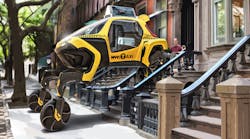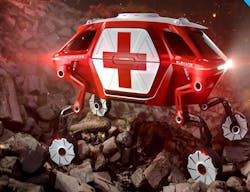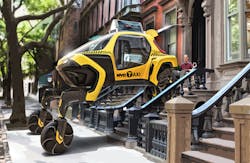Hyundai’s new “Elevate” vehicle literally walked onto the global stage at the recently held CES in Las Vegas. The vehicle concept that Sundberg-Ferar developed for Hyundai’s CRADLE division provides a new vision of transportation mobility.
The need for efficient, rapid, resilient transportation for disaster assistance is what led Hyundai to develop the first-ever vehicle with movable legs. Elevate is the first ultimate mobility vehicle (UMV), blending technology found in electric cars and robots, which allows it to traverse terrain beyond the limitations of even the most capable off-road vehicle.
Any first responder will tell you that the first 72 hours following a natural disaster are the most crucial to saving lives. However, often times due to the nature of the disaster (forest fire, earthquake, hurricane, or flood), it can be difficult for search-and-rescue and humanitarian aid missions to reach and get immediate help to those in need. A car with legs could drive first responders to a location like any traditional vehicle, but then walk or climb over treacherous terrain to directly reach the injured or stranded.
“When a tsunami or earthquake hits, current rescue vehicles can only deliver first responders to the edge of the debris field. They have to go the rest of the way by foot. Elevate can drive to the scene and climb right over flood debris or crumbled concrete,” said John Suh, Hyundai vice president and head of Hyundai CRADLE. “This technology goes well beyond emergency situations - people living with disabilities worldwide that don’t have access to an ADA ramp could hail an autonomous Hyundai Elevate that could walk up to their front door, level itself, and allow their wheelchair to roll right in – the possibilities are limitless.” Figure 1 shows the ambulance version of the Elevate.
1. The Elevate as an ambulance.
A New Kind of Mobility
Hyundai CRADLE, which stands for Center for Robotic Augmented Design in Living Experiences, delivers better mobility through pioneering robotics that deliver a greater quality of life. The Elevate concept is based on a modular EV platform with the capability to switch out different bodies for specific use cases. The legs are attached to the cradle chassis, which houses the battery. The robotic leg architecture has five degrees of freedom plus in-wheel motors that are enabled by the latest in electric actuator technology.
Such a design is uniquely capable of both mammalian and reptilian walking gaits, allowing it to move in any direction. The legs also fold up into a stowed drive-mode, where power to the joints is cut, and the use of an integrated passive suspension system maximizes battery efficiency. This allows Elevate to drive at highway speeds just like any other vehicle. But no other can climb a five-foot wall, step over a five-foot gap, walk over diverse terrain, and achieve a 15-foot-wide wheelbase, all while keeping its body and passengers completely level.
The engineering team validated realistic driving and walking range capabilities by running simulations through the famous Rubicon Trail. There are 17 stages to the trail, which were broken into five severity levels, each requiring different levels of leg articulation and scaled power consumption to match the demand of the obstacles. Mixing that with drivable portions of the trail, the engineers packaged a 66-kWh battery that would allow Elevate to traverse the demanding 22-mile trail.
In early design explorations, the team studied possible hydraulic solutions to power the legs. While hydraulics are proven to work at vehicle scale, new developments in electric actuator technology proved to offer a greater range of motion, while delivering the right amount of torque in an efficient package.
The scaled robot was developed to study the articulation capabilities of a fully electric actuator architecture and begin control programming of the robotic limbs. All of the joints in this scale model perfectly match the proportions of the final design. This is not only a revolutionary design in quadruped robotics, capable of both reptilian and mammalian walking gates, it also has the added complexity of wheels as the feet can lock but also roll, enabling dynamic driving capabilities in these various positions.
People living with disabilities worldwide who don’t have access to an ADA ramp could hail an autonomous vehicle that could walk right up to their front door. It could step over their flower garden and level itself to their door, allowing their wheelchair to roll right into the vehicle (Fig. 2).
2. The autonomous vehicle could be a boon to wheelchair-bound people who don’t have ramp accessibility.
By combining the power of robotics and Hyundai’s latest EV technology, Elevate has the ability to take people where no car has been before, and redefine the perception of vehicular freedom and mobility.
Sundberg-Ferar at a Glance
Sundberg-Ferar, located in Metro Detroit, specializes in innovation strategies, design research, industrial design, user interface, ergonomics, engineering, model making, and packaging. For decades it spearheaded the cross-category design trend by specializing in multiple categories, namely consumer products, medical equipment, and vehicles of all types.




